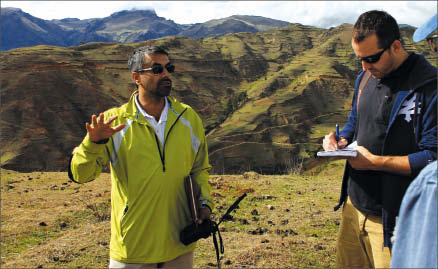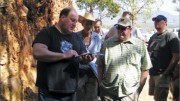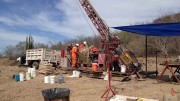It all started with a phone call. On the line was Standard Bank, looking to auction off some Peruvian properties after a joint venture between two majors had gone sour. On the other end of the line was Panoro Minerals (PML-V), which had worked in Peru but was mired in its own troubled joint venture in the Philippines, hoping to find a way out.
“We were basically at the end of a rope when that call from Standard Bank came in,” says Christiaan Staargaard, a Panoro director, as we sit in a hotel lobby in downtown Cuzco.
Staargaard explains how Antofagasta (ANTO-L) and Vale (VALE-N) had put together a Peruvian joint-venture company called Cordillera de las Minas with 14 properties, but through poor co-operation, divergent priorities or for some other reason, the joint venture fell through and the two majors wanted out. So in 2007 Standard Bank organized an auction with dozens of companies bidding, and Panoro lost.
But once again Standard Bank came through with a lifeline phone call, informing Panoro that the winning bid had been dropped and they were next in line. The company promptly signed on to pay $13 million in cash and 6 million shares for Cordillera de las Minas and its portfolio of properties, and the company has been focused on Peru ever since.
Staargaard, along with president and CEO Luquman Shaheen, explain this bit of company history as we wait to take a helicopter ride to Cotabambas, their flagship project. The project is accessible by road, but it’s a four-hour trip along windy, switchbacking roads through the highland Apurimac region of Peru. By helicopter it’s a 20-minute flight to the project, which is 50 km southwest of the tourism hot spot and Inca capital of Cuzco.
Panoro is in good company, with several major players either buying into the region, or already long established. Xstrata (XTA-L) is moving ahead with a $4.2-billion Las Bambas project that hosts 1.1 billion tonnes grading 0.77% copper, and sits some 38 km south of Cotabambas, as well as its $1.5-billion development of Antapaccay. Southern Copper (SCCO-N) is advancing its Los Chancas project, First Quantum Minerals (FM-T, FQM-L) spent $460 million acquiring the Haquira copper project in late 2010 and HudBay Minerals bought the Constancia copper project for $520 million in March 2011.
Flying high above the largely treeless valleys and plateaus that make up the region, there is little evidence of civilization besides the meandering lines that constitute road access. As we approach the project the 3,000-person town of Cotabambas comes into view, as do the spattering of houses and small fields that make up the three indigenous communities in the area.
We land right on the Ccalla deposit, the much larger of two deposits, with the Azulccaca deposit sitting over a hilltop 800 metres to the south. We’re standing on a hilltop plateau covered in scruffy grass, looking quite similar to the surrounding terrain. But underneath us, and extending to the southwest, sits 80 million tonnes of a 90-million-tonne project resource grading 0.77% copper and 0.42 gram gold per tonne, with the rest hosted at Azulccaca.
Shaheen wants to at least double that resource with the existing 11,800 metres of core from Vale and Antofagasta, and through the new drilling the company is working to complete.
“Not only are we adding a lot more data to grow the resource from our twenty-four thousand metres of drilling, but also we’re going to make better use of the pre-existing data to get more tonnes,” Shaheen says.
The company is re-logging and assaying old core and samples because Vale and Antofagasta did not concern themselves too much with formal quality assurances and controls when drilling the property, which led to less mineralization being incorporated into the existing resource.
The majors also spaced wide at around 200 metres, which meant even more potential mineralization was excluded.
“Because there wasn’t enough data,” Shaheen explains in the on-site office, “the confidence in the geological model wasn’t strong enough to give credit that there’s mineralization between drill holes. We’ll be filling in those gaps.”
Thanks in no small part to Luis Vela, who came on as exploration manager a few months ago and whom Shaheen describes as a “breath of fresh air for the project,” the company is looking at the geology of the whole area differently. Vela used the recently completed 162-line-km magnetic survey and 85-line-km induced-polarization survey to determine that the Ccalla and Azulccaca deposits do not connect as previously believed, but instead extend in separate, parallel structures in a northeast-southwest direction.
Standing next to one of the hillside drill platforms, Vela points out the clear change in soil colour in the middle of the valley, from a burnt red to a light tan, which he says indicates a change in the geological setting and shows a distinct gap in the two mineralization bodies and reinforces the survey data.
The company has now identified areas of low chargeability designated as numbers one to four on the ends of both deposits that could host further mineralization, as well as two porphyry targets to the west called Huaclle and Cochapata.
“Our target areas for exploration and future resource growth are three to four times what we have at Ccalla,” Shaheen says. “The big upside is still there, we’ve still got a lot of work to do on it.”
The latest results from Cotabambas include hole 40, which hit 105 metres grading 0.51% copper and 0.26 gram gold per tonne and 117 metres grading 0.46% copper and 0.27 gram gold, and hole 41, which cut 76 metres averaging 0.51% copper and 0.29 gram gold, and 111 metres carrying 0.37% copper and 0.18 gram gold. The company reports that the two holes, drilled at the southern end of the defined deposit, confirm the strong continuation of the Ccalla deposit to the southwest.
A technical report on the project states that the Cotabambas porphyry cluster is dominated by two plutons of diorite and granodiorite with numerous dikes and stocks of andesite and microdiorite, all belonging to the Andahuaylas-Yauri batholith.
The company has been working to secure a fourth rig to accelerate the program, but with the country’s exploration boom they are hard to come by. If all goes to schedule the drill program should wrap up in less than five months, after which the company will upgrade the resource.
The program should cost about $10 million, while Panoro had $8.5 million on-hand in November after a $7.4-million financing in July at 45¢ per unit. The company’s stock price swung as high as 81¢ in March but has generally hovered around the 45¢ mark, with 138 million shares outstanding. The company could see another $4.5 million come in from warrants that expire in April and May, and could see more money coming in if it resolves the issues surrounding its other main project: Antilla.
The company’s 100%-owned, 74-sq.-km Antilla project is located 140 km southwest of Cuzco and hosts a 154-million-tonne resource grading 0.47% copper and 0.01% molybdenum.
The current hold-up on Antilla is the “100% owned” part, which became less clear after Panoro joint ventured the project to privately owned Peruvian company Chancadora Centauro. The Peruvian company had initially committed to making cash payments of US$8 million to Panoro and investing US$17 million in Antilla to earn 70% of the project. But after Centauro paid the initial US$1 million cash and began drilling the project, the scheduled payment of US$4 million within 90 days did not come in. Two months after the payment deadline passed, and a scant six months after initially signing the deal, Panoro terminated the joint venture. The two sides have been locked in arbitration proceedings to settle the matter since late 2010.
Despite the drawn-out nature of the proc
ess, Shaheen is optimistic of the eventual outcome. He puts it as a win-win: If Panoro loses the arbitration, it will get $7 million in cash, plus 30% of a feasibility stage project. If it wins, the company gets full control of the project, plus $4 million cash. Shaheen is expecting to know the results in a matter of months, but can’t be sure how long the process will take.
Staargaard believes that the whole issue came about because the other company knew Panoro had little money, and was trying to squeeze them by holding off on paying the US$4 million to get a better option deal. Fortunately for Panoro, a $2-million financing quickly turned into $6.5 million, and the company was able to shift its efforts to Cotabambas as the arbitration ground on.
The other big break was that the company finally reached a community agreement with the Cochapata indigenous community at Cotabambas in March 2011, allowing for expansion of its drill and exploration program on the project.
The company had already reached community agreements with the Ccalla and Guaclle indigenous communities in the area, each numbering around 150 to 300 people, but for some time had not been able to secure a deal with the Cochapata. With the deposit sitting on the edge of the Ccalla and Cochapata communities, agreements were not only necessary but critical to a stable, long-term exploration program.
Increased attention to indigenous rights and anti-mining sentiment in Peru has only made these agreements more important, and potentially more difficult to secure. Bear Creek Mining (BCM-V), Southern Copper (SCCO-N) and most recently Newmont Mining (NMC-T, NEM-N) all felt the sting of community opposition last year, each having a major project suspended temporarily or indefinitely.
Peruvian President Ollanta Humala, feared by the mining industry before the election for his left-leaning past, has established himself as decidedly pro-development – if done responsibly. In the high-profile scuffle over Newmont’s $4.8-billion Conga project, Humala cracked down on protestors and imposed a state of emergency as a sign he had only so much patience for disruptions of an already approved project. But the government is working to find a balance going forward, most recently proposing that an environmental conservation fund be included in future mining contracts and setting up an agency to settle social conflicts relating to the mining project.
With Panoro still at the exploration stage there is less to disagree over, but Shaheen says that is due in part to broken promises from past operators. The Cochapata community was distrustful of the company and did not even want to talk with them. Panoro worked with two other communities and built up a good rapport in the region before dialogue started and a deal was finally reached.
“Trust goes a long way,” says Shaheen, who has considerable experience to this side of the exploration business. An engineer by training, he worked for 12 years in Latin America as a consultant on water, environmental and community issues, including a stint as Pan American Silver’s director of environmental affairs before joining Panoro.
The company has reminders all around of the perils of not having the community on side. Candente Copper (DNT-T) – the only other junior that fully controls an advanced copper project in Peru – has been unable to advance its flagship Canariaco project because of delays with drill permitting and community agreements. At Panoro’s own Kusiorcco project, sitting near HudBay’s Constancia project, the company is still working on securing property agreements with the indigenous community of Achuccaro. Meanwhile the company has had environmental approval to drill the 4-sq.-km porphyry intrusive since late 2009. And while Panoro began working at Antaquilla in 2008, it had wanted to start at Cotabambas but couldn’t because it had no community agreements in place.
“The geology was always better at Cotabambas, but the community was easier at Antaquilla,” Shaheen says.
But now that agreements are in place, some 60 to 80 people in the communities are working for the company. Panoro has also established school scholarships, improved irrigation, brought in satellite TV and Internet and attends monthly community meetings to keep an open dialogue going.
While waiting to board the helicopter at the end of the site visit, Shaheen is approached by a few locals, fresh from hand-tilling the hard soil and wearing sandals that look like they were made from old car tires. He shakes their hands and launches into a conversation in Spanish, talking about their concerns and the goings-on about the community. It’s the kind of engagement required these days for projects to succeed.
And with the resource expanding and community relations going well, Shaheen is confident of continued success.
“This will be a mine,” Shaheen says, looking around at the copper-rich hills, trusty cigar in hand. “The question is the scale.”





Be the first to comment on "Panoro explores for riches in Peru’s heartland"